Master AP Calculus AB & BC
Part III. FOUR PRACTICE TESTS
ANSWER KEY AND EXPLANATIONS
Section I, Part A
|
1. D |
7. C |
13. B |
19. C |
24. A |
|
2. C |
8. B |
14. E |
20. D |
25. C |
|
3. C |
9. C |
15. A |
21. D |
26. C |
|
4. B |
10. E |
16. E |
22. E |
27. E |
|
5. C |
11. E |
17. D |
23. D |
28. A |
|
6. B |
12. D |
18. E |
|
|
1. The correct answer is (D). To determine where the derivative of a function is increasing, we should find the zeros of the second derivative and examine a wiggle graph.

The second derivative is equal to zero when x = 0 and when x = 1/3. By examining the wiggle graph below, we can determine the interval on which the derivative is decreasing.

The second derivative is negative over (0,1/3).
2. The correct answer is (C). We can convert these parametric equations into the following Cartesian equation: y = 1 — x2. So, the area under the curve would be given by

3. The correct answer is (C). Although —3/2 is a zero of the derivative, the derivative does not change signs there.
4. The correct answer is (B), Use integration by parts. Letting u = ln x and dv = x dx yields
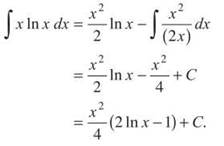
5. The correct answer is (C). Let’s begin by examining h’(x):
![]()
In order for h to have any relative extrema, its derivative, h’, would have to equal zero at some point. Since g is always decreasing, g’ is never zero and since g’ is the numerator of h’, h' is never zero. Therefore, h has no relative extrema.
6. The correct answer is (B). By reading the graph, we learn that f'(2) = 0. Using point-slope form, we get an equation of the tangent at (2,5) to be
y - 5 = 0(x - 2)
which becomes
y = 5
7. The correct answer is (C). Points of inflection correspond with horizontal tangents of the derivative. Since there are two such tangents, there are two points of inflection.
8. The correct answer is (B). The maximum accumulated area under the graph of f' occurs at x = 2.
9. The correct answer is (C). Since the degree of the numerator is greater than the degree of the denominator, we should first divide and integrate the quotient.

10. The correct answer is (E). This question is asking for an interval where both the first and second derivatives are positive.
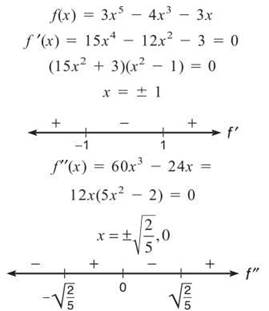
By examining both of the preceding wiggle graphs, we can see that the curve increases and is concave up from 1 to infinity.
11. The correct answer is (E). First, let’s determine the value of y when x = 1.
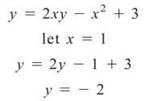
Now, we differentiate the equation with respect to x:
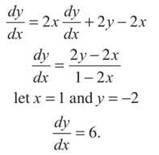
12. The correct answer is (D). The length of a curve defined parametrically is given by

Applying the formula above gives us
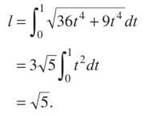
13. The correct answer is (B). Since we are asked for the average value, we use the MVT for integrals.
![]()
We need to use power reducing formulas.
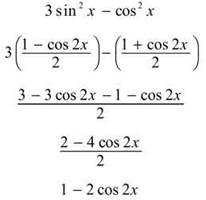
Now, integrate to get the answer.

14. The correct answer is (E). For what value of k will the left- and right-hand derivatives be equal? If k = 2/3, then the derivatives will be the same; however, the function is then discontinuous because the left - and right-hand limits are different.
15. The correct answer is (A). This is a Taylor or Maclaurin series that you should commit to memory.
![]()
Substituting 3 for x yields

16. The correct answer is (E). This is a very involved integration-by-parts problem. Use a chart.
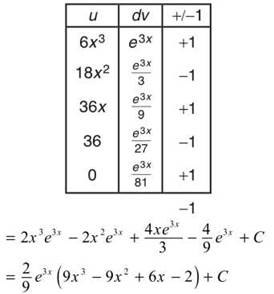
17. The correct answer is (D). Since f(x) = secx, f’(x) = secxtanx. secx is never zero, and tanx = 0 when x = 0, x = π, or when x = 2π. So, the answer is 3.
18. The correct answer is (E). To determine R3, L3, and M3, we need to be able to sum the areas of the rectangles. R3 = 14, L3 = 5, and M3 = 35/4. To determine T3, we need to find the area of a triangle and two trapezoids. T3 = 19/2. Using the fundamental theorem, ![]()
19. The correct answer is (C). Applying the ratio test to the first series,

= 2 > 1, so I. is divergent
Applying the comparison test to the second series and comparing it to the harmonic series helps us conclude that II. is divergent as well.
The third series is really just ![]() which is a p-series with p > 1, so it is convergent.
which is a p-series with p > 1, so it is convergent.
20. The correct answer is (D). The two curves intersect at θ = π/4 and θ = 3π/4. So, the area would be given by
![]()
21. The correct answer is (D). We must set the two derivatives equal to each other and solve for k.

22. The correct answer is (E). We apply the following formula:
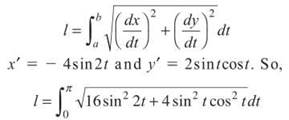
23. The correct answer is (D). First, we’ll take the limit of the ratio test:
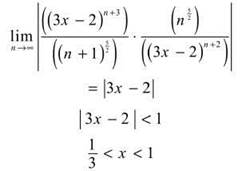
In order to test the end points, we substitute each end point into the original series and test for convergence. By letting x = 1/3, we get ![]() which converges.
which converges.
If we let x = 1, we get ![]() , which converges as well.
, which converges as well.
So, the interval of convergence is 1/3 ≤ x ≤ 1.
24. The correct answer is (A). Horizontal asymptotes are determined by finding the limit at infinity. If we multiply the binomials we can see that the ratio of the leading coefficients is 3/2.
25. The correct answer is (C). Notice that all of the slopes on the line y = —x are zero (horizontal). Any point on this line would make ![]() be zero, since x and y are opposites.
be zero, since x and y are opposites.
26. The correct answer is (C). This is an improper integral and a tricky integration-by-parts problem. First, we’ll deal with the improper integral by taking the limit of a definite integral:
![]()
We now have to use integration by parts on ![]() We’ll choose u = x2 and dv = e-x dx and get
We’ll choose u = x2 and dv = e-x dx and get
![]()
Now, well let u = 2x and dv = e-x dx and get

Now, we have to evaluate the integral using the limits of integration and take the limit as p goes to infinity, so
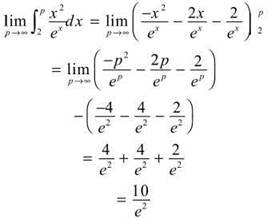
27. The correct answer is (E). If we factor out a 1/100 from this expression, we get
![]()
This indicates that the maximum population, P, would be 500; anything greater and the growth rate would be negative.
28. The correct answer is (A). ![]()
![]() So,
So, ![]()
![]()
Section I, Part B
|
29. B |
33. A |
37. D |
40. D |
43. E |
|
30. D |
34. A |
38. B |
41. A |
44. C |
|
31. E |
35. D |
39. D |
42. C |
45. B |
|
32. D |
36. B |
|
|
|
29. The correct answer is (B). This is the Taylor series for y = 1/x. We can use our calculator to determine that these two graphs intersect at x = 0.567.
30. The correct answer is (D). This is a second derivative problem.

31. The correct answer is (E). The formula for the area of a square is A = x2/2, where x is the length of the diagonal. If we differentiate this formula with respect to t, we get
![]()
Since we know that ![]()
![]()
Now, we have to express x, the diagonal, in terms of P, the perimeter.
x = s√2 where s is the length of a side.
So,
![]()
and

Substituting gives us
![]()
32. The correct answer is (D). We need
![]()
If we factor and cancel, we get
![]()
33. The correct answer is (A). For this problem, we have to solve an equation for a limit of integration. This is the equation we must solve:
![]()
If we integrate and apply the fundamental theorem, we get
![]()
We can use our calculator to determine that k = 1.239.
34. The correct answer is (A). We must differentiate implicitly with respect to x.
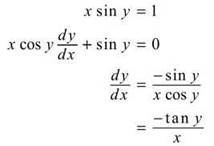
35. The correct answer is (D). This problem involves simple substitution and the properties of the definite integral.
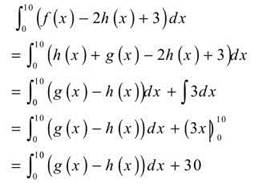
36. The correct answer is (B). The fifth-degree Taylor polynomial for ex centered at x = 0 is
![]()
So,

37. The correct answer is (D). We first want to take the limit of the ratio test.
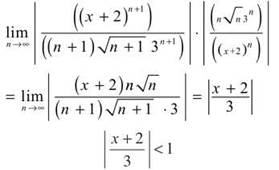
So,
- 5 < x < 1
If we test the end points, we’ll find that the series converges at both of them, so the radius of convergence is
- 5 ≤ x ≤ 1
38. The correct answer is (B). First, figure the trapezoidal approximation using n = 6:

Now, we can use our calculator to divide ![]() This comes out to 0.978.
This comes out to 0.978.
39. The correct answer is (D). If we examine the figure, we’ll see that y = 3 — x2 is the top curve.
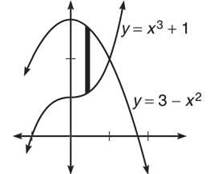
Since the two curves intersect at (1,2), the limits of integration are 0 and 1. Using the washer method, the volume would be
![]()
Since this is not a choice, we should switch the limits of integration and factor out a negative to get
![]()
40. The correct answer is (D). In order to determine the tangent line, we need two things: a point and the slope. To find the slope, let’s find g'(2). This is a simple application of the second fundamental theorem:
![]()
To find a point on the tangent line, we need to evaluate g(2):

So, we write the equation for the line through ![]() with a slope of √2.
with a slope of √2.
![]()
This can be transformed into
![]()
41. The correct answer is (A). We are looking for the graph of the derivative of the given graph. Since g has only one horizontal tangent, we can expect its derivative to have only one zero.
42. The correct answer is (C). The formula for the sum of an infinite geometric series is
![]()
Substituting a = 5/4 and r = 2/7 gives us
![]()
43. The correct answer is (E). The average rate of change is just the slope of the secant, which is
![]()
Since it is strictly monotonic and f(10) > f(5), then/is increasing over the interval [5,10] and the absolute maximum must occur at x = 10. The absolute maximum is 26. Since 8 is on the interval [5,10] and f is increasing over this interval, f'(8) > 0.
44. The correct answer is (C). We are going to find the antiderivative of f(x) = e2x.

Since we are given the initial condition that F(0) = 2.5,

Substituting this gives us
![]()
Now, using our calculator, we can determine F(5) to be 11015.233.
45. The correct answer is (B). To find the volume of a solid with known cross sections, we integrate the area of these cross sections. So, the volume would be given by

Section II, Part A
1. (a) The formula for a Taylor series expansion is
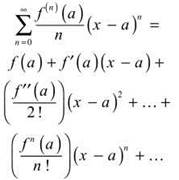
We are given the values of the function and the first three derivatives when x = 1. We can just plug these into the formula and get
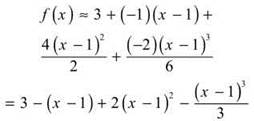
Now, we use this polynomial to find f(1.1) ≈ 2.920.
(b) This is the derivative of the polynomial in part A.

(c)
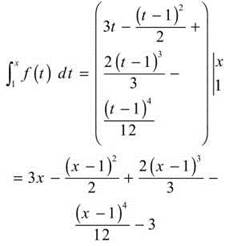
(d) Can f(2) be determined from the information given? Justify your answer.
No, we only have information about f(1). We can only approximate values other than that.
2. (a)

Since f(0) = 2, we substitute 0 for x and 2 for y:
e2 = C
Substituting back, we get
ey = x3 + x2 + e2
Now, we solve for y by taking the natural log of both sides:
y = ln (x3 + x2 + e2)
(b) Remember, the domain of a natural log function is the set of all numbers for which the argument is positive. So, using the calculator, we can determine that x3 + x2 + e2 is positive for all x > -2.344.
(c) Where does the second derivative change signs?

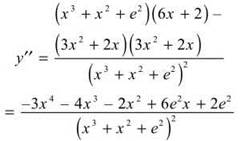
We are really concerned about where the numerator is zero, so well set it equal to zero and use our calculator to solve for x.
-3x4 - 4x3 - 2x2 + 6e2x + 2e2 = 0
The graph of y = —3x4 — 4x3 — 2x2 + 6e2x + 2e2 crosses the x-axis in two places: x = —0.331 and x = 2.128. So, this function has two points of inflection: x = —0.331 and x = 2.128.
3. (a) We first use our calculators to determine the points of intersection, which are x = —2.028 and x = 1.428. Also, we can tell from the calculator that y = —x2 + 3 is the top function. So, the area of R could be determined like this:

(b) We are going to use the formula for arc length twice, once for each curve:
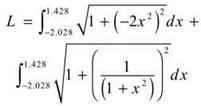
(c) We need to integrate the area of a semicircle. Remember, the formula for the area of a semicircle is ![]() First, we should determine r. This should be 1/2 the distance between the curves. So,
First, we should determine r. This should be 1/2 the distance between the curves. So, ![]() So, the volume of the solid is given by the following
So, the volume of the solid is given by the following
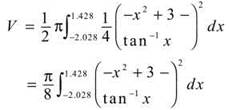
Section II, Part B
4. (a) A relative minimum exists wherever the value of the derivative changes from negative to positive. This happens twice: at x = —2 and at x = 6.
(b) A relative maximum exists wherever the derivative changes from positive to negative. This occurs at x = 4.
(c) There are four possible absolute minimums: x = —3, x = —2, x = 6, and x = 8. These are the relative minimums and the end points. We should examine the accumulated area under the derivative’s graph for each one. Upon doing so, we see that the area between the derivative’s graph and the x-axis is least at x = —2. So, the absolute minimum occurs when x = —2.
(d) Since there is a vertical tangent line at x = 3, the derivative of the derivative does not exist there. Also, since there is a cusp at x = 5, f"(5) does not exist either.
5. (a)
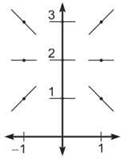
(b) Point (0,3): ![]() ∆y = (.2)(0) = 0. The new point will be (0 + .2, 3 + 0) = (.2,3).
∆y = (.2)(0) = 0. The new point will be (0 + .2, 3 + 0) = (.2,3).
Point (.2,3): ![]()
![]() ∆y = (.2)(.2) = .04. The new point will be (.2 + .2, 3 + .04) = (.4,3.04).
∆y = (.2)(.2) = .04. The new point will be (.2 + .2, 3 + .04) = (.4,3.04).
Therefore, f(0.4) ≈ 3.04.
(c)
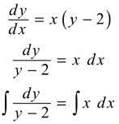
![]()
Now, we will substitute in our initial condition of x = 0 and y = 3:

By substitution,

6. (a) This involves finding the antiderivatives of both components of the velocity vector:
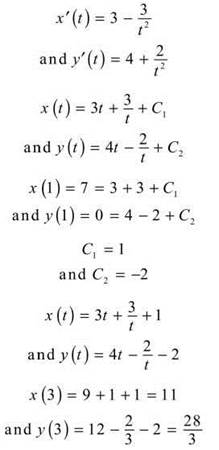
So, the position of the particle when t = 3 is ![]()
(b) The slope of the tangent line is equal to

In order for the slope to be zero, we would need the numerator of dy/dx to be zero:
![]()
However, there are no values for t that would make this equation true. Therefore, the line tangent to the path of the particle will never have a slope of zero.